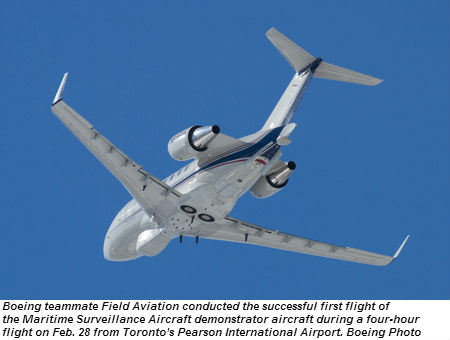Boeing’s Maritime Surveillance Aircraft (MSA) demonstrator recently completed its first flight to verify airworthiness, an important milestone toward providing a low-risk and cost-effective maritime surveillance solution designed for search and rescue, anti-piracy patrols and coastal and border security.
Boeing’s MSA program teammate Field Aviation, a Field Aerospace company, successfully completed the flight testing. The demonstrator is a Boeing owned Challenger 604 and is the prototype platform upon which Boeing will develop its MSA program based on the Bombardier Challenger 605.
Field Aviation has carried out modifications to the airframe and systems which include the design, manufacture and installation of provisions for Search Radar, retractable EO/IR camera, ESM, Comint and other communication systems. The four hour long testing took place on Feb. 28 from Toronto’s Pearson International Airport.
“We accomplished everything we set out to achieve,” Field Aviation pilot Craig Tylski said. “The aerodynamic performance was right on the money and even with the additional aerodynamic shapes, such as the radome, the demonstrator performed like a normal aircraft. The control and handling were excellent.”
Following this first fight, the MSA demonstrator has been flown to a Boeing facility in Yuma, AZ, where Field Aviation will continue working towards completion of its flight test program, leading to FAA and Transport Canada certification. Upon flight test completion, Field Aviation will deliver the modified MSA demonstrator to Boeing in Seattle for integration of the MSA’s sensors and communications subsystems.
Additional airworthiness flights are scheduled for the next two months. Once they are complete, the aircraft will fly to a Boeing facility in Seattle where the MSA mission systems will be installed and tested.
MSA uses proven technologies developed for Boeing’s P-8A Poseidon program to provide multi-mission surveillance capabilities. The baseline configuration features an Active Electronically Scanned Array multi-mode radar, an Electro/Optical/Infrared sensor, Electronic Support Measures, a Communications Intelligence sensor and Automated Identification System.
Boeing achieved first flight of the MSA demonstrator on an accelerated schedule due to rapid prototyping and lean manufacturing techniques by Boeing Phantom Works, the company’s advanced technology organization, working closely with industry teammates.
Boeing has selected the Challenger 605 business jet as the MSA platform and will leverage Field Aviation’s engineering and modification experience with the Challenger family of aircraft to modify the jet.

